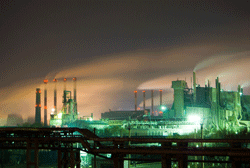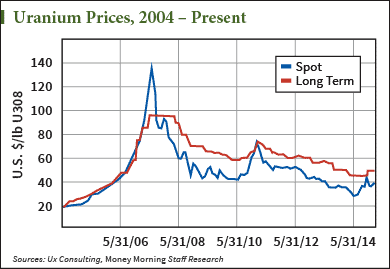After four challenging years in the uranium space, there are finally signs suggesting this part of the commodities market is due for a recovery...
Uranium has been one of the worst performing commodities markets for years. Since 2011's pivotal Fukushima reactor leak, the price of uranium fell by more than half.
At best, uranium explorers and producers have gone sideways. At worst, some have gone under.
But we're at a pivotal point in this sector right now. Demand is about to jump, uranium supply outlook is getting tighter, and Japan's nuclear needs are coming back.
In fact, within the next two years, this commodities market is forecast to face a deficit scenario that will drive prices higher once again...
Commodities Market Focus: Uranium Demand Coming Back
In the wake of the Japanese tsunami that destroyed its Fukushima reactor, 54 of the country's reactors were shut down. That resulted in as much as 10% of world uranium demand disappearing.
But Japan has been gradually returning to nuclear power.
It's now four years later, and approval's been given to restart four reactors, with another nine awaiting the green light.
Since those events, there are now an additional 11 reactors under construction globally (totaling 69) and an additional 31 on order or in planning stages (totaling 183).
 As you can see from those numbers, nuclear as a form of electricity generation has continued to grow, albeit at a slower pace than it was before. And it will keep growing.
As you can see from those numbers, nuclear as a form of electricity generation has continued to grow, albeit at a slower pace than it was before. And it will keep growing.
Globally there are hundreds of new reactors either under construction or in planning stages. The United States is the largest consumer of uranium in the world, requiring more than 50 million pounds annually, yet producing only 4.7 million pounds domestically.
China consumes 19 million pounds per year, and that's expected to reach 73 million pounds by 2030. China, too, only produces about 4 million pounds annually.
All of this is developing against a backdrop of shrinking supply that will simply be unable to match demand any time soon...
Commodities Market Pricing: As Simple as Supply and Demand
Across the globe there's been significant damage to the supply side of the equation.
Falling uranium prices have caused numerous, especially higher cost producers, to scale back. Some mines have shut down entirely, while others have seen output reduced. Certain projects have been placed on care and maintenance, or worse, canceled entirely.
The 20-year Megatons to Megawatts program, whereby Russia sold low enriched uranium to the United States, ended in December 2013. That has removed 24 million pounds annually of secondary supply. Of course, current Western sanctions on Russia are also weighing on uranium supplies sourced in Russia.
Recent developments in Australia and Canada are likely to further limit future uranium output from those countries as well.
Australia, the third-largest uranium-producing nation, has recently seen the state of Queensland re-impose a uranium mining ban.
That now means no new projects can be developed for the foreseeable future in that state, although exploration can continue.
It's not difficult to imagine that few resource companies will find much reason to spend valuable dollars or time looking for uranium with so much uncertainty hanging over the sector.
And Australia's not alone...
[epom key="ddec3ef33420ef7c9964a4695c349764" redirect="" sourceid="" imported="false"]
Back in 2013, Canada's province of Quebec decided to ban exploration and development. It became the third province to do so, following in Nova Scotia and British Columbia's footsteps.
Now, it appears, all of this reduced output is starting to show up in the uranium price...
Uranium Prices Ready to Reverse
Given the delays the industry faces to go from exploration through to discovery, permitting, financing, construction, and finally production, it's likely we're going to see considerably higher prices.
That's huge for a commodities market that saw about a 60% price loss in three years. Since Fukushima in early 2011, the spot uranium price fell steadily from about $73 down to near $28 in mid-2014.
 Since then, there's been a marked recovery to the current $39 level, meaning spot uranium is actually up nearly 40% in the last nine months. It's looking increasingly like last summer's $28 low is the bottom for the current cycle.
Since then, there's been a marked recovery to the current $39 level, meaning spot uranium is actually up nearly 40% in the last nine months. It's looking increasingly like last summer's $28 low is the bottom for the current cycle.
What makes this more interesting is that only 15% of uranium is supplied at spot prices, with the other 85% being sold under long-term contracts. The long-term price appears to have bottomed back in the fall of 2014 around $44, with recent contracts trading up at the $49 level.
Analysts estimate that new production of uranium from conventional mining projects requires a price of $83/lb. Right now, about 56% of world mine supply is sourced from conventional mines. So the bar is pretty high, at more than double the current spot price.
Supply is likely to stay thin until uranium prices rise enough to encourage renewed production and/or exploration. Given the current gap between spot and required prices for profitable mining, it could be a while yet.
For investors, here's the best low-risk way to play this commodities market now.
Commodities Market Profits: How to Play Uranium
Uranium Participation Corp. (TSE: U) is a way to own the fuel, at least indirectly. About half the ETF is made up of U3O8 and the other half UF6. U3O8 is a more basic, unrefined uranium, whereas UF6 is an intermediate-stage product before converting to nuclear fuel.
As of Feb. 28, the fund's net asset value was $6.27 (CAD) per share. Recently shares have traded around $5.60, implying a discount of nearly 12% at current prices.
Remember, nuclear power is a crucial source of power for a large share of the world's population. And at its current price many producers are losing money.
The laws of supply and demand are pointing to higher prices in this commodities market before long. Now's the time to participate.
Make More Money This Year, No Matter What the Market Does... You can make 2015 your wealthiest year in a few simple moves. You just need the three common investing habits to dump immediately, the single most effective strategy for your portfolio, and five stocks to get you started to a wealthier you. Get all of that right now in this exclusive guide...


